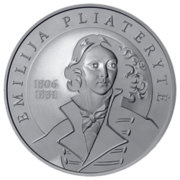Emilia Plater
Countess Emilia Broel-Plater (Lithuanian: Emilija Pliaterytė; 13 November 1806 – 23 December 1831) was a Polish–Lithuanian noblewoman and revolutionary[1] from the lands of the partitioned Polish–Lithuanian Commonwealth.
She raised a small unit, participated in several engagements in present-day Lithuania, and received the rank of captain in the Polish insurgent forces.
[12] A single child, she was brought up by distant relatives, Count Michał Plater-Zyberk and his wife, Izabela Helena Syberg zu Wischling (1785-1849), in their family's manor Līksna near Daugavpils (Dźwina), then Inflanty (now Latvia).
She was raised in an environment that valued the history of Poland, and her literary heroes included Princess Wanda and Adam Mickiewicz's Grażyna.
[12] She also admired Laskarina Bouboulina, a woman who became one of the icons of the Greek uprising against the Ottomans,[12] Polish fighter Anna Dorota Chrzanowska,[12] as well as Joan of Arc.
[12] In 1823, one of her cousins was forcibly conscripted into the Imperial Russian Army as a punishment for celebrating the Constitution of 3 May; this incident is said to be one of the key events in her life and one that galvanized her pro-Polish and anti-Russian attitude.
[12] After the outbreak of the November Uprising against Imperial Russia, she became a vocal supporter of the anti-Tsarist sentiments in the lands of the former Grand Duchy of Lithuania.
[12] In her note from 25 March written at the Antazavė Manor, Plater claims that joining the uprising was her sole idea and that she had hoped to go to war her entire life.
[20] She then turned to Samogitia and headed for Panevėžys, where on 30 April she joined forces with the unit commanded by Karol Załuski [pl].
[12] On 5 May, she witnessed General Dezydery Chłapowski entering the area with a large force and taking command over all units fighting in the former Grand Duchy.
[12] However, after separating from the main force, accompanied by Maria Raszanowicz and her cousin Cezary Plater, she became seriously ill.[12] The uprising ended in October and many of her biographies claim that the heartbreak exacerbated her illness leading to her death.
[25] Stefan Kieniewicz, in a more critical treatment in the Polish Biographical Dictionary, notes that a lot of her exploits are poorly documented, and it is not always possible to separate legend from facts.
[25] In the Polish literature, Plater's life is featured in a novel by Wacław Gąsiorowski [pl], seven plays, and several poems, including those by Antoni Edward Odyniec and Maria Konopnicka.
[31][32] A four-act play Les Polonais: événements historique by Charles Prosper was performed at the Cirque Olympique in Paris in 1831.
[38] She also became the theme of paintings by several artists of the epoch, among them Hippolyte Bellangé, Achille Deveria, Philipp Veit, and Wojciech Kossak.
[25] A lithograph by François Le Villain based on Deveria's work became one of the most recognizable portraits of her, popularizing her image as a delicate and noble female warrior.
[40] Several streets, including one in Warsaw [pl][2][25] In Kapčiamiestis, a small memorial museum in her honor was opened in 1984 and a monument to Plater by sculptor Antanas Ambrulevičius [lt] was erected in 1999.
Artistic and historical exhibitions commemorating Emilia Plater have been taking place in Belarus, although her figure remains largely ignored by the official state ideology of the Lukashenko regime.





